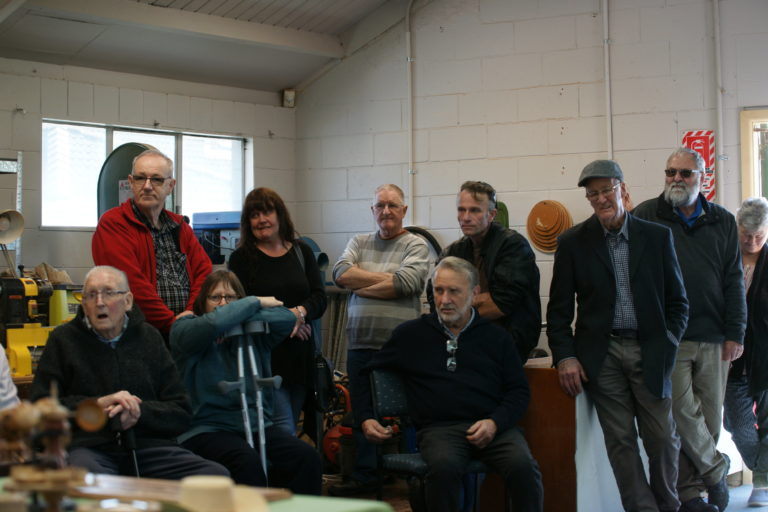Make one of these kauri crescent clocks that are in demand around the world
By Mac Duane
Photographs: Gerald Shacklock
A crescent clock looks at its best if it is made from a stylish native timber.
For this project, I used a kauri block. When you come to select the wood which will be prominently on display in the living room or dining room, for preference choose a piece of timber that has a distinctive grain.
First, I cut a 300mm diameter circle of timber. It can be smaller if you wish. Any larger and it becomes quite unwieldy when you offset it on the lathe to form the crescent.
To start, I drill a 60mm-wide hole about 5mm deep, enough to get a grip with a 50mm chuck. True up the outside of the piece, rounding off the edges. Then true each side down to about 60mm. Sand and apply the finish as you can’t do anything to this piece after you have cut the crescent out (except clean up the cut of the crescent).
The next step is to cut the crescent. To do this, take the piece you have just turned and finished, and lie it on the bench with the grain running horizontally. Measure 20mm out to one side and drill a 7mm hole through the piece. This gives you the offset to form the crescent.
Having drilled the hole and set the timber wheel off-centre on the lathe on a screw chuck, mark the small side on the tool rest so you know where to rest the chisel to cut in the crescent shape. When the wood spins, you can’t tell where the short or long edge is. The chisel, a parting tool, gets hot, so rest and check the crescent shape from time to time.
Cut the groove separating out the crescent down to a thickness of 3-4mm away from the back. Do not cut right through because the crescent will go flailing around on the lathe. Cut the last bit off on the bandsaw. Saw the crescent ends at an angle to create a taper with the same thickness on either side.
Apply finish early
Measure for offset
Drill 7mm hole
Mark small side on tool rest
Spinning crescent looks symmetrical
Do not cut through
Back
Return the timber disc to the screw chuck with the back facing outwards. Clean up the outside, rounding off the edge. Inscribe an internal circle with a pencil to outline the 100mm-diameter aperture for the clock movement. Turn out this recess to a 10-20mm depth.
To make the back look less plain, I put in lines of decoration on the body outside the recess. I emphasise these by holding a black pencil in the lines while turning the clock body. The pencil marks show up as black lines under the sealer. Instead of a pencil, you could use a piece of Formica held against the wood while the clock body turns on the lathe – the edge held into the line burns a black mark into the block.
Put sanding sealer on as a finish, as it lasts well. I have a bowl where I used sanding sealer and although the bowl is ten years old, it still has the gloss finish.
Finish on bandsaw
Clean up outside
Back: sanding sealer
Front
Mount the back on the chuck using the 100mm recess created for the clock movement. Now true the front up and cut it back to form the recessed clock face. Remember always to rub the bevel, so that you get a smooth finish. Rubbing the bevel is bringing the bevel or sloped face of the chisel to the work, and turning it to cut. In other words, don’t hold it square.
The clock face within the rim should be about 200mm across. I choose to fit long clock hands and cut them off to suit. Turn down the clock face recess down to about 10mm in depth over the recess on the back. This allows for the clock movement to come through when it is fitted in the rebate in the back.
It’s very important for the first 30mm in from the edge of the rim to be flat all round, so that the numbers will stick on easily. Round off the edges of the clock face with a round-nosed scraper.
For decoration, I score lines into the face and like to embellish the front edges with a rotary burr or Dremel to provide visual interest. Scribe two lines around the outsides of the edge frame and decorate between the lines with the Dremel. By flowing this texture in between the lines around the circumference of the clock face, you virtually create a picture border and so you’ve “framed the clock”.
Front recess
Dremel decoration
Sanding crescent
To sand the crescent, I use sandpaper wrapped around a 150mm long, 75mm diameter drum with a spigot at one end. Put the spigot of the sander drum into the chuck, and sand the crescent against the drum turning.
It’s handy to have a reversing lathe. When you sand the crescent with forward lathe movement, it pulls the crescent away from you and could whip it out of your hand. A reverse on your lathe makes the crescent easier to handle, as the direction of spin pushes the shape against your body. If you do not have a reverse lathe, you could stand on the other side. Round off the edges of the crescent by sanding them. Work down through three grades of paper, coarse, medium, and fine grit, and sand by hand.
Drum-sand crescent
Drilling crescent
The whole clock is held by wooden pegs pushed through the top and bottom of the crescent and into the clock disc. You have to drill the holes through the top and bottom of the crescent directly opposite each other. I like to place the pegs which support the clock at the bottom right of the crescent and at the top left. You can choose where you put them, but to have the pegs supporting the clock body straight across the centre line of the clock looks better. I use a jig to hold the crescent clock body for drilling and it saves me a lot of anguish over getting these holes lined up straight.
To get the best look, line up the grain of the crescent around the clock. Then line up the drill centre on the clock frame, like a tailstock point, with the point of the drill on the line of the jig. I work on the centre line – don’t drill on either side. I also mark the bottom of the clock side with a B for base, otherwise, you could turn the clock face 180° the other way when you come to place it in the crescent, and have the grain mismatched.
Drill crescent using jig
Clock face grooved
Pegs
Make the pegs out of a small oblong of kauri about 30mm by 30mm. The pegs I used for this clock are 40-50mm long, and the peg-top is approximately 25mm in diameter. The peg-top can be big or small, depending on what look you prefer.
Make the peg shaft the same size as the drill bit for the hole, which in this case was 10mm in diameter. When turning the pegs, start with the work on the head, otherwise, the head being worked chatters too much if you have fined and turned down the stem first.
When placing the pegs, glue only the bottom one in for spacing. Leave the top peg loose so it can be taken out if you need to work on the movement of the clock in the back. The clock should have enough space to come up off the short bottom peg and be lifted out of the crescent.
Decorated kauri peg
Base
The clock sits firmly on a base and doesn’t pivot, despite appearances. To create the base, I use a 100mm round of kauri on a screw chuck. Turn the base down to a 30mm or so thickness before rounding off the sides so it doesn’t look clumsy. I keep the bottom of the base at 100mm diameter to provide stable support for the clock. I used the rotating burr (Dremel) for decoration between the lines I scored towards the top and bottom of the sides of the base, and once again darkened these lines with a pencil.
Base: kauri round
Turn down base
Numbers
After assembling the clock, fit the movement and position the numbers. I stand a square plumb with the centre hole and then mark the position of the number 12 (in this case Roman XII), fit the movement, and a set of hands.
|The XII in place will cover this mark. I use a short hour hand to it doesn’t impede the placing of the numbers. Turn the hands using the adjustment wheel on the movement at the back, so you don’t strip the gears. Place the numbers when the long hand returns each time to the twelve.
When you buy your numbers they have a sticky back on them. This isn’t enough to hold over a long period. Some super glue is in order, but don’t try putting it on the back of the numbers directly. The glue will run to the front and you’ll find yourself stuck to the numbers when you press them onto the face. Place a little super glue on a piece of paper and then use a pin to place a small drop on.
TIP: If you have to remove the hands to work on the clock movement, avoid damaging the fragile hands by lifting them off gently with a kitchen fork at the centre.
Square locates number 12
Place hands first
Stick on numbers



